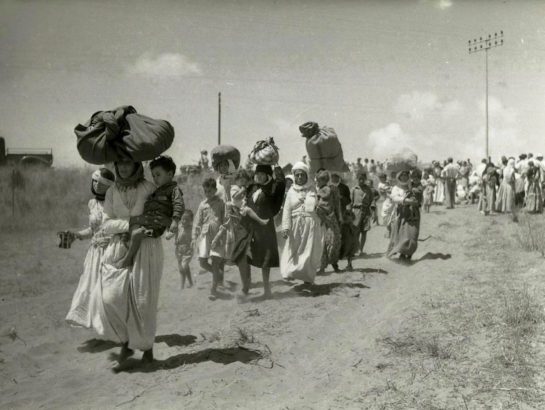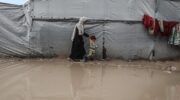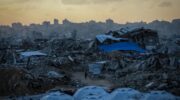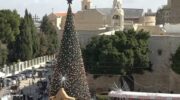‘”Place the Material in the Wells..” Documents from Israeli archives reveal the Israeli army’s 1948 biological warfare… Some oral testimonies have previously reported about this – now two Israeli historians have found the ‘smoking gun’…
Three additional articles below report on some of the recent incidents of Israelis poisoning Palestinian wells…
by Ofer Adaret, reposted from Ha’aretz, October 14, 2022
On April 1, 1948, David Ben-Gurion wrote in his journal about “the development of science and speeding up its application in warfare.” A month and a half later, he wrote about “biological materials” that were purchased for $2,000. Only now, 74 years later, has a connection between these two entries come to light.
The disturbing story behind them was recently uncovered by historian Benny Morris and historian and Israel Prize laureate Benjamin Z. Kedar following extensive archival research. Evidently, the excerpts from the diary of the man who would become Israel’s first prime minister are traces of his involvement in a secret operation to poison the drinking water of Arab communities during the War of Independence.
This operation was partially exposed decades ago when rumors and oral testimonies were reported in newspapers and books about an attempt in 1948 by the IDF to poison wells in Acre and Gaza by adding bacteria to the drinking water. However, only now, in Morris and Kedar’s research, has the “smoking gun” been revealed – in the form of official documentation.
The newly unearthed documents show that this operation was much broader in scope than earlier believed and that other top military and political figures besides Ben-Gurion were involved.

“We uncovered a lot of new information. We deciphered how the operation developed through its various stages; we discovered who authorized, organized and controlled the operation, and how it was carried out in different areas,” Morris says.
“We have a much fuller picture now, and one that is based in part on IDF documentation,” Kedar adds.
The pair recently published an article in the journal Middle Eastern Studies titled “‘Cast Thy Bread’: Israeli Biological Warfare during the 1948 War.” “Cast Thy Bread” was the operation’s code name.
Naturally, most of the material related to the episode is censored, but when Morris searched through the IDF archives for any mention of the operation by name, he was surprised to discover numerous documents.
Morris writes in the article that the censor apparently was not aware of what the code name referred to.
Water warfare in Israeli leaders’ own words
Dayan – now calling himself, in code, “Moshe Neptune” – cabled Yadin: “Cast Thy Bread will be activated by Nahshon [meaning Operation Nahshon forces, which included the Harel Brigade] on Monday or Tuesday. I will come down mid-week with all the material.”
Yadin instructed senior IDF commanders: “There is an immediate need to appoint in your HQ a special officer for Cast Thy Bread matters. The matter is of utmost importance and must be kept in great secrecy by you.”
In another cable, Yadin writes: “Place in the wells material of the Cast Thy Bread type.” And in another cable: “Is there authorization to use B [the Hebrew letter Bet] in the areas that will be evacuated by us [i.e., Israel]?”
The operation began in April 1948, when fears of an invasion by Arab armies were mounting. The plan was to poison wells in abandoned Arab villages as well as in Jewish locales that were due to be evacuated by the state-in-the-making.
To prevent Palestinian return
The idea was to prevent Arabs from returning to their villages and from settling in Jewish locales that would fall into their hands.
The operation initially focused on the area between Jerusalem and Tel Aviv, and later expanded to Acre in the north and Gaza in the south. The evidence indicates that it later included – either in planning or in effect – other communities such as Jericho, Be’er Sheva, Ilaboun, Bidu, Beit Suriq, Beit Mahsir and Har-Tuv (after the Jews were evacuated).

The possibility of adding targets outside of Israel such as Cairo and Beirut was also proposed, but nothing came of it. The idea behind that was to hinder the Arab armies’ advance.
Morris found dramatic evidence about the operation in the archives of Kibbutz Na’an, in testimony provided in 1988 by a kibbutz member, the archaeologist Shemarya Guttman, who was a Palmah commander and senior IDF intelligence officer.
Guttman told of how General Yohanan Ratner, the senior commander whom Ben-Gurion tagged to head the operation, informed him about sending “two people to the Egyptian border to do this job [concerning] wells.”
The two were David Mizrahi and Ezra Horin (Afgin), who set out for the mission in Gaza on May 22, 1948, but were caught and tried in an Egyptian military court for poisoning wells with bacteria, and later executed.

Guttman recounts that he vehemently opposed the operation on moral grounds and also warned that poisoning the water could harm Jews as well. “Look, we may also conquer this area tomorrow and drink from this water, and all our army will also be sick with typhus or dysentery,” he told Ratner.
When he asked to be issued the order in writing, his request was refused. “[Ratner] said to me, ‘I will never give such a thing [in writing].’” Guttman goes on to report that he asked “what sort of material were they talking about – ‘liquid or powder … and he then decided it would be powder.’” He also notes that “the two were caught red-handed.”
Another testimony located by Morris and Kedar was hidden in an interview given by former ambassador Asher Ben-Natan to historian Nir Mann in 2008. Ben-Natan described another phase of the operation: an attempt to poison wells in Cairo.
In the summer of 1948, Ben-Natan was in Paris as part of his position in operational intelligence. Intelligence officer Binyamin Gibli met him there and gave him “a capsule to be used for poisoning wells in Cairo.”

Top Israeli leaders
But the plan was scrapped and, said Ben-Natan, “I was left with the poison capsule, and in the end, I destroyed it in the sewer.” Morris and Kedar also found evidence of this in the IDF archives, in a document from September 1948, in which Yadin writes: “Please call soon … in regard to activation of Cast Thy Bread abroad.”
The documents show that Ben-Gurion was at the top of the pyramid. Below him was Yadin, who oversaw the military side of the operation. The operation was commanded by Yohanan Ratner. Initially, the top man in the field for the group was Dayan, who went on to become the IDF chief of staff and defense minister.
The documents indicate that Dayan served as the smuggler who conveyed the bacteria from the Science Corps to different points throughout the country.

David Shaltiel, commander of the Etzioni Brigade in Jerusalem, was also involved in the operation. Intelligence officer Ezra Helmer (later Omer, head of the Haganah General Staff Intelligence Department) also joined at a later stage. The identity of another person who was involved in the operation remains uncertain. In cables, he is referred to as “Mizrahi.”
In the beginning, it was ordinary soldiers, such as soldiers from the Harel Brigade’s fourth battalion, who did the dirty work of poisoning the wells.
Later on, the job was given to members of the Palmach’s Arab division, the “mistarvim,” who specialized in sabotage operations and assassinations in enemy territory.
On the scientific side, the production of the poison, were people from the IDF Science Corps Bet, a subunit in the Science Corps that dealt with biological warfare.
It was headed by Alex Keinan, who went on to found the Israel Institute for Biological Research in Nes Tziona.
The scientific work was overseen by the Katchalski (Katzir) brothers: biophysicist Ephraim Katzir, the first commander of the Science Corps and later an Israel Prize laureate and the fourth president of Israel; and his older brother, scientist Aharon Katzir of the Weizmann Institute, who was killed in the 1972 terror attack at Lod Airport.
“A series of assistants who went on to become professors in Israeli academia were also involved in the operation,” Morris says.
The operation echoed the plan of the “Avengers” led by Abba Kovner to poison water and food sources in Germany after World War II to cause mass killing.
The Katzir brothers were also involved in this operation, and supplied the poison to Kovner, but ultimately he, too, threw it into the sea before he was arrested by the British.
Morris and Kedar believe that the objective of the IDF operation was not to cause mass killing but rather to disrupt the Arabs’ moves.
Ultimately, the operation did not change the face of the war. According to various reports, several dozen Arabs did fall ill, mainly in Acre.
The operation drew scathing criticism within the system – both within the IDF and among the Yishuv leadership – in part because it violated the 1925 Geneva Protocol banning “the use of bacteriological methods of warfare.”
Ofer Aderet is an Israeli journalist for Ha’aretz
Illegal Israeli Colonists Poison Water Well Near Hebron
Several fanatic illegal Israeli colonists poisoned, Thursday, a Palestinian water well east of Yatta town, south of Hebron, in the southern part of the occupied West Bank.
Rateb Jabour, the coordinator of the National and Popular Committees against the Annexation Wall and Colonies in southern West Bank, said the assailants came from the illegal Ma’on colonialist outpost, which was built on private Palestinian lands, east of Yatta town.
Jabour added that the colonists dumped blue liquid toxins in the well in the al-Hamra area in the at-Tiwani, near the outpost, and stated that the well was used by local shepherds to provide water for their flock.
The attack is the latest in a serious of assaults and violations targeting the Palestinians, especially the shepherds and farmers, to force them out of their lands so that the colonists can expand their illegal outposts.
Settlers poison Palestinian well
by Khaled Amayreh, reposted from Al Jazeera, February 21, 2005
Last week [February 2005], heavily armed settlers from the settlement of Yitzhar, near Nablus, vandalised and sabotaged the water supply on which the nearby village of Madama depends.
The latest poisoning is the seventh of its kind during the past three years, according to village officials.
An Israeli army spokesman said the military is looking into the matter.
Yitzhar was established more than 20 years ago on confiscated land belonging to the people of Madama and is inhabited by Talmudic settlers seeking to expel non-Jews from Palestine and Israel.
Jewish settlements built on occupied Palestinian lands are deemed illegal under international law.
‘Organised terror’
According to Madama’s local council head Ayid Kamal, Yetzhar has always been “a source of provocation, vandalism and organised terror”.
“They come in broad daylight and throw filthy materials like diapers and poisonous substances inside the spring’s source, and when we complain to the Israeli authorities, they tell us the army cannot do anything about it.”
Kamal said the ultimate goal of the settlers is to force the villagers to leave their land.
Last year as many as 12 children in the village were diagnosed with liver infections and many others developed stomach pains as a result of drinking contaminated water.
The Yetzhar settlers also burned down standing crops belonging to the villagers, often in full view of the Israeli army.
Connivance suspected
Palestinian villagers, as well as some international aid workers, suspect there is connivance between the settlers and local Israeli army members.
The British charity Oxfam had repaired the water system at Madama, covering the natural spring’s mouth with concrete.
Palestinians say the settlers’ real goal is to grab their land
However, every time new pipes are installed, the settlers smash them and contaminate the spring water by dumping hazardous materials, local residents said.
In two instances, settlers opened fire on Palestinians and foreign aid workers in the area.
An Oxfam spokesman said the charity would once again try to undo the damage.
“We want to help those helpless people, we hope the Israeli authorities will get serious with the settlers and stop their actions,” a spokesman said.
A Palestinian Farmer Finds Dead Lambs in His Well. He Knows Who’s to Blame
By Gideon Levy and Alex Levac, Ha’aretz, March 14, 2019
The carcasses of some 10 sheep and lambs were dumped into Ibrahim Salah’s well. The poisoning of its water is only one instance of what the people of his village endure at the hands of settlers from nearby Havat Gilad… Read more
RELATED:
Israel’s history of biological warfare & poisoning – violations of int’l law
RELATED READING ON ISRAEL, PALESTINE, AND WATER:
- Israel says “No” to clean running water for Palestinian villages
- Heart-wrenching firsthand account of Israeli water criminality
- Water Works in Gaza Destroyed
- Israeli Settlement Pollutes Palestinian Olive Groves With Sewage Water
- Water headlines everywhere, and Palestinians come up dry: Israel’s latest actions against Gazans
- Israel’s use of skunk water is damaging Palestinian health and economy
- Israel’s ongoing “Water War” against Palestinians
- Baseline of a Desecrated Land XI: Love Child of the American Water Bureaucracy
VIDEOS:





